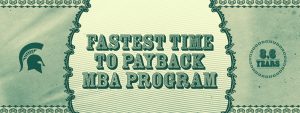When considering whether to pursue an MBA, many students think: “Is it worth two years and the tuition dollars?” One of the tools MBAs learn to assess investment decisions is a payback analysis.
 But when looking for the quickest return on investment in an MBA education, Forbes ranked the Broad College of Business Full-Time MBA Program as one of the country’s best choices. According to its latest rankings of full-time MBA programs, released today, Broad students tied for the shortest payback time among all MBA programs ranked: just 3.6 years to make up the costs of their MBA degrees in additional compensation.
But when looking for the quickest return on investment in an MBA education, Forbes ranked the Broad College of Business Full-Time MBA Program as one of the country’s best choices. According to its latest rankings of full-time MBA programs, released today, Broad students tied for the shortest payback time among all MBA programs ranked: just 3.6 years to make up the costs of their MBA degrees in additional compensation.
“The ranking demonstrates the value of our two-year MBA program. Students can invest two years and get back their investment quickly upon starting their new lives as a Broad MBA,” said Glenn Omura, associate dean for MBA and professional master’s programs. “This allows our students to get on with their lives and not be overburdened with debt. Our team is focused on customizing each of our MBAs’ educational experience, in a way that broadens their knowledge base across business disciplines and specific competence in their chosen fields that prepares them to solve problems creatively and innovatively and, ultimately, to make business happen.”
Another investment analysis tool is return on investment (ROI). Forbes bases its biennial MBA rankings entirely on calculations of ROI, which come from measuring compensation five years after graduation and subtracting tuition costs and salary forgone during school.
The 2017 ranking placed Michigan State University’s Full-Time MBA program No. 9 among public schools and in the top 25 overall, consistent with its position over the past decade.
The magazine surveyed the Class of 2012 and requested pre-MBA salaries and compensation for three of the first five years after receiving degrees. Forbes then compared their post-MBA compensation with their opportunity cost: tuition costs, as well as the estimated salary they would have made, had they stayed in their old jobs. Salary figures were adjusted to account for cost-of-living expenses, and the earnings gains were discounted using a rate tied to the discount rate large companies’ pension funds use.
For more information about this ranking, visit forbes.com.




